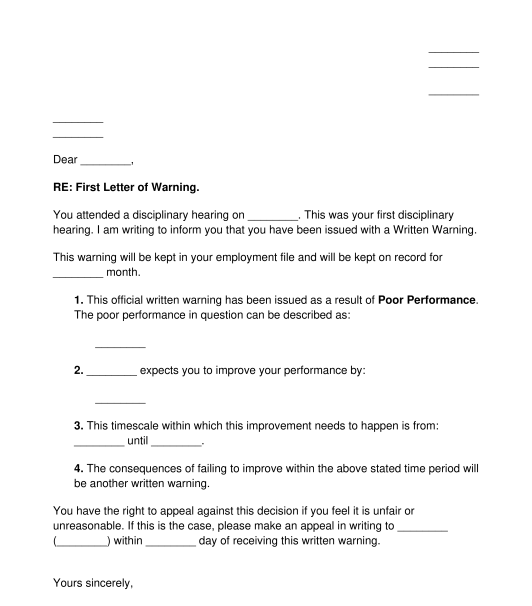 04/09/2025
04/09/2025

Answer a few questions and your document is created automatically.

Your document is ready! You will receive it in Word and PDF formats. You will be able to modify it.

 04/09/2025
04/09/2025
 Word and PDF
Word and PDF
 1 page
1 page
A warning letter for an employee following a disciplinary meeting is a formal letter an employer sends to an employee during the disciplinary process after the employer has held a meeting with the employee. The letter may be a general or final warning letter given to the employee. An example of where such a letter may be used is when an employer intends to discipline an employee for misconduct at the workplace.
No, in the strict sense, it is not mandatory for an employer to issue a warning letter to an employee following a disciplinary meeting. However, the employer should give one to the employee. This is because it will show that the employer has given the employee a fair disciplinary process and, as such, reduce the risk of a legal claim by the employee.
Before a warning letter is issued to an employee, there should be an ongoing or beginning disciplinary process in response to the employee's conduct. This disciplinary process will have been started in accordance with the employer's disciplinary policy.
A warning letter following a disciplinary meeting only applies to individuals who have been hired under an employment contract. This means that independent contractors operating under a service contract or consultancy agreement cannot be issued such a warning letter. If the employer is dissatisfied with the actions of an independent contractor, it will have to address the conduct through the avenues provided in the contract (e.g the service agreement or consultancy agreement).
Once the warning letter has been drafted, it should be signed by the employer or by a person who has the authority to do so on the employer's behalf (e/g/ HR Manager, Welfare Officer), The letter should then be sent to the employee directly, either physically or by email. The employer should also keep a copy of the warning letter for its records.
A warning letter for an employee following a disciplinary meeting should contain the following:
LRA Code of Practice
UK Government Guidance on Dismissal
You fill out a form. The document is created before your eyes as you respond to the questions.
At the end, you receive it in Word and PDF formats. You can modify it and reuse it.
Guides to help you
Country: United Kingdom